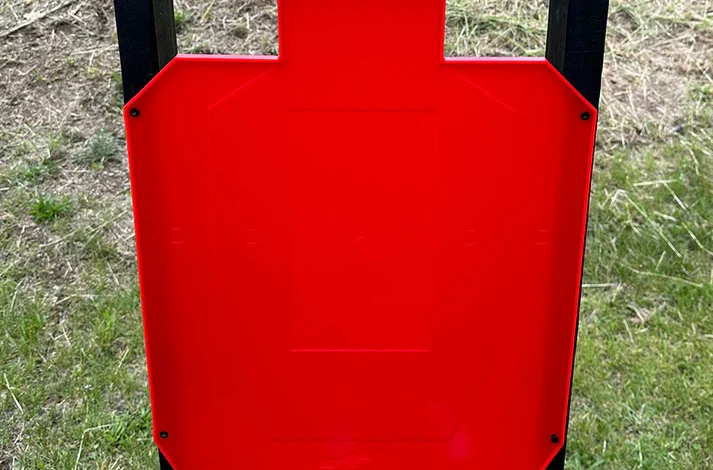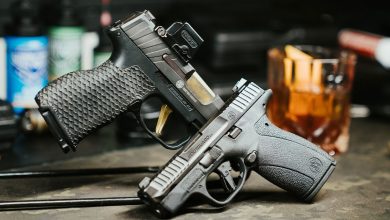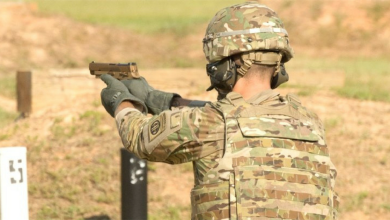DA Targets Self-Healing Targets – The Truth About Guns

I have a local range that’s only about 10 minutes from my house. It’s a great club, with nice facilities. The only downside is that you need to bring your own target stands. I like shooting steel, but dragging that back and forth can be a pain. I have target stands that take cardboard backing, but I seem to be always replacing those. When I saw the self healing targets from DA Targets earlier this summer though, I thought it might be a great alternative to either of those.
DA Targets Self-Healing Targets
DA Targets is located in my home state of Pennsylvania, albeit on the other side of the state. Still, I always like supporting home state businesses. When I saw their targets pop up on social media I decided to take a closer look. What sets their targets apart from what I had been using is their self-healing technology.
They use a polymer that instantly seals after the bullet passes through. I was familiar with this type of material from using Caldwell reactive targets for years, but DA Targets takes things a step further.
Self-Healing Technology
DA Targets makes full and half-sized silhouette targets, as well as 4-inch and 6-inch gongs. They use a self-healing polymer that seals up after the bullet passes through the target. The targets are rated for everything from .22 LR to .308 Winchester and larger. They recommend full metal jacket and round nosed bullet profiles and advise to avoid hollow points, wadcutters and blunt-faced projectiles. More on that later. DA Targets also cautions that rounds traveling under 800 FPS are not recommended as they can ricochet off of the pliable polymer material.
Being that the rounds pass through the target there is no danger of spalling or ricochets like with steel targets. Although you do need to follow the minimum 800 FPS advisory to avoid bounce back.
With proper ammo, the DA Targets will last for thousands of rounds of use. They’re rated to take 10,000 rounds of 9mm. For a casual shooter one target could literally last a lifetime. Obviously many repeated hits in the same area can degrade parts of the target faster than others, but the durability is impressive. The polymer material is also weatherproof, and unaffected by rain or snow, unlike cardboard targets. It’s considerably lighter than a steel target as well.
Patented Color-Changing Capability
Okay, so while all that sounds good, there are other companies that offer self-healing targets as well. What sets the DA Targets apart from the crowd? Well they have a trick up their sleeves for that, and it’s a good one. The DA Targets change color at the point of impact when you shoot them.
DA Targets uses a patented heat activated material. When their targets are struck by a bullet, the target temporarily changes color at the point of impact. It shows a colored ring where the bullet struck. This gives you instant feedback, and lets you see where you’re hitting and how you’re grouping.
The color change is visible by eye from the 25-yard line, and would be easily visible through a magnified optic at further ranges. The color change lasts for a few minutes so you have plenty of time to see how you’re hitting. Once the color fades, the target is back to its base color and you’re ready for your next course of fire. You don’t get the clang of the hit like when you shoot steel, but you get an instant and easy to see visual confirmation of your shots.
The color changing targets come in three temperature ranges allowing you to choose which is best for your environment and shooting conditions. These accommodate the ambient air temperatures and ensure that the color change technology works correctly. DA Targets does advise to protect your targets from UV light when not in use. So you don’t want to leave them set up on the range for days at a time between range sessions.
Currently DA Targets offers this tech in full regulation-sized silhouettes, half-sized silhouettes and in the 4-inch and 6-inch gongs. They also offer a series of gongs that have the self healing technology, but not the color changing option.
Target Set Up
I received a full-sized warm weather-rated silhouette, as well as a 6-inch non-color changing gong for testing. The warm weather target is rated for temperatures between 60 and 100 degrees. On the various days shooting, I used the target in temperatures at both ends of that spectrum.
I mounted my full-sized silhouette to a 1×2 frame that fits into the target base I normally use for paper targets. The DA Targets silhouette was a little narrower than the upright spacing on my stand so I angled them in a bit to compensate. I added a top and bottom crossbar and then screwed the target in place.
DA Targets suggests wood screws, and they have holes placed along the perimeter of the target so you don’t need to drill through the target material. I did that initially and thought that it was fairly secure. One of the range days was windy though, and my target got knocked over a couple of times, and the target popped free of the screw heads. I was able to use a heavy duty staple gun to staple it to the frame as a temporary fix. At home I ended up adding some washers to the wood screws to increase the surface area over the attachment points. That worked well and is what I plan on doing in the future with any additional targets. Alternatively, DA Targets says that you can use clamps to attach the target to your target stands. That should work well too, as long as you don’t shoot your clamps off.
Since I had the gong as well, I screwed it into the base of the silhouette and left it hanging beneath the “torso” of the target. You never know when you need to practice that shot.
The full-sized silhouette only weighs 5 pounds, so even with the frame and target stand, it weighed substantially less than my half-sized steel target and stand. Tossing the target in the back of my Jeep was fast and easy. Set up at the range was equally quick. Being that I didn’t need to staple targets up, it was even faster than using my same target stands with a cardboard backer.
Range Tests
I used the Self Healing Targets over the summer and had them at the range on at least 8 trips. I went with a few buddies on various days, and by myself a couple times as well. We put hundreds of rounds through the targets. It was a mix of .22 LR, .22 Mag., 5.56mm, .30 carbine, 9mm, .40 S&W, 10mm, .38 Special and even some 8mm Nambu.
Temperatures ranged from the high 60’s to the high 90’s on various days. It was interesting to watch the target color react to the various temperatures. The base target color is black, and it seemed to hold that color until the temps started climbing to around 80 degrees. At that point you could watch the entire target turn from black to red. On the 90 degree days it turned red as soon as I took the target out of the car.
When the target was black, with temps around 60 to 80 degrees, hits would show up as red rings around the impact point. On the hotter days, from 80 up into the 90s, when the target was red, the circles around the hits showed up as yellow. Either color was easy to see.
Do’s and Don’ts
I mentioned earlier about using the proper ammo types on the self-healing targets. Overall durability was very good. I had no issues with any of the rounds tested with FMJ loads. Spitzer-type rifle bullets were no issue, nor were round-nosed pistol rounds. Even truncated cone FMJ loads were fine. .22 LR rounds, whether plated or not, also caused no problems. I wondered how lead round-nose .38 Specials would do, but we tested a couple first before doing serious shooting with them, and they seemed fine as well. I did refrain from using .45-70 and .50 Beowulf on the target as I didn’t want to push the self-healing limits beyond a reasonable measure.
I did run into two issues while testing the targets over the summer, and both were user errors. On the first range trip out I realized my buddy was shooting .22 Mag. at the 6-inch gong hanging from my target stand. When questioned on what ammo he was using, he showed me that it was a hollow-point round. That was my fault, as I hadn’t briefed him on the ammo limitations of the targets.
We went downrange and examined the gong for damage. Sure enough there were cavities in the back of the target where the .22 Mag. hollow points passed through. The front surface though had still healed up fine after the round passed. Despite the damage caused, the target was still perfectly functional and should be good for many more rounds to come. Luckily we caught the issue after just one magazine was fired, so the damage wasn’t bad.
Later in the same range session, I ended up putting some .40-caliber hollow points through the silhouette target. My buddy was blameless for his ammo choice, as I hadn’t briefed him on it. I just screwed up. I have an ammo can of old, mixed .40 rounds and was loading mags from it. I wasn’t thinking that there were some hollow points in that mix. I fired one magazine downrange before I realized the issue.
When I checked the target there were neat, round cookie cutter holes through the target material where the .40-cal. rounds hit. On the plus side, I can tell my readers that there is in fact a reason to follow the manufacturer’s ammo recommendations. Better that I screw it up for you, so that you know better when you get your own target!
Despite the damage, there is still a lot of life left in the target. It was thankfully only a handful of rounds, and they weren’t grouped tightly, so I have a few small holes, not one huge hole to contend with.
Wrap Up
DA targets offers the full sized silhouettes for $180. Half-sized silhouettes go for $80. Color changing gongs are $28 for the 4-inch gong and $43 for the 6-inch. The non-color changing gongs go for $23 for a 4-inch gong and $38 for a 6-inch gong. You can also get a knock down gong for $58 with a stand for a non-color changing model and $63 for the color changing version.
While those prices are certainly more than you’re going to spend on paper targets, you don’t need to keep buying these. One target could potentially last a casual shooter a lifetime. Even for a heavy shooter, or use at a gun club or public range, you’re going to get a lot of life out of these targets before they need replacement.
When compared to steel, they’re way lighter and easier to set up. While you don’t get the audio feedback of shooting steel, you do get immediate visual feedback that you don’t have with most paper targets. You can also use these targets on ranges that prohibit the use of steel. Add in the fact that the DA targets polymer is maintenance free, and I think you get a lot of value for your investment.
If you’re tired of lugging steel to the range, or constantly swapping out paper targets, then check out DA Targets before your next range trip.
Check out Ammo To Go, the ammunition retail sponsor of TTAG. Get your bulk and quality ammo for a bargain by visiting their site.
All product and gun reviews are performed independently and product mentions made based on the quality of the product and value of interest to gun owners. We offer links to mentioned products as a convenience to readers interested in learning more about each product, as well as to provide a fast, easy way to purchase that item if desired. Please note when you buy through links on our site, we may earn a commission to help support the costs of operating our site and keeping it free for our visitors.
Read the full article here






